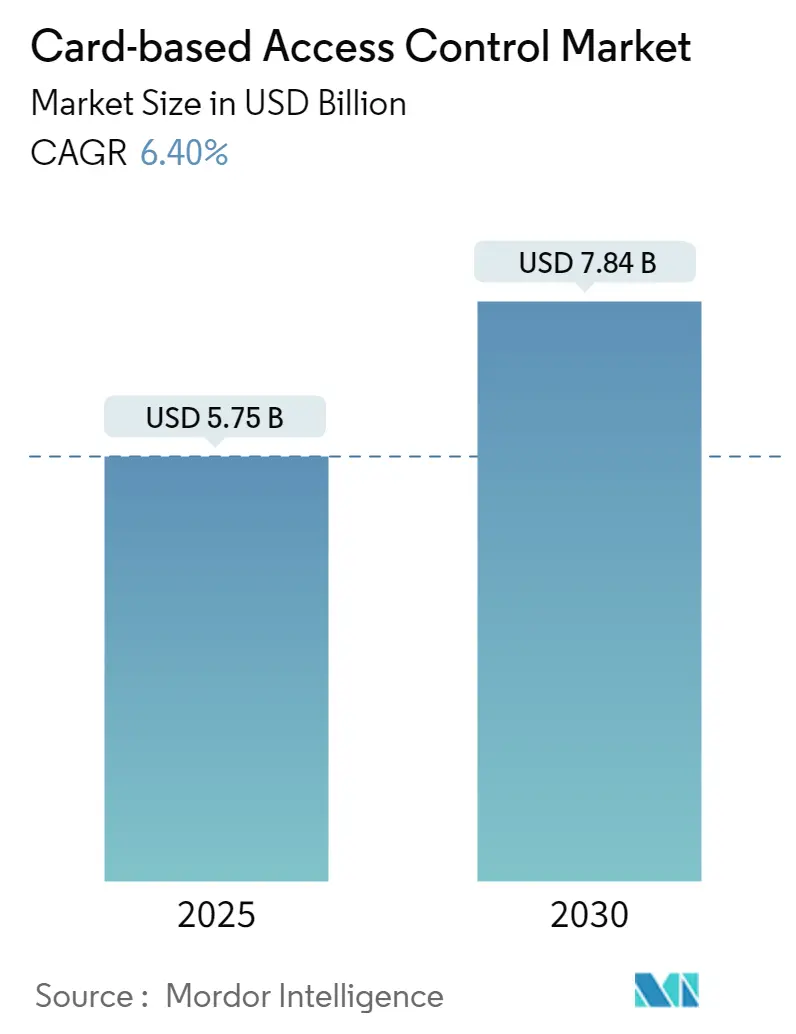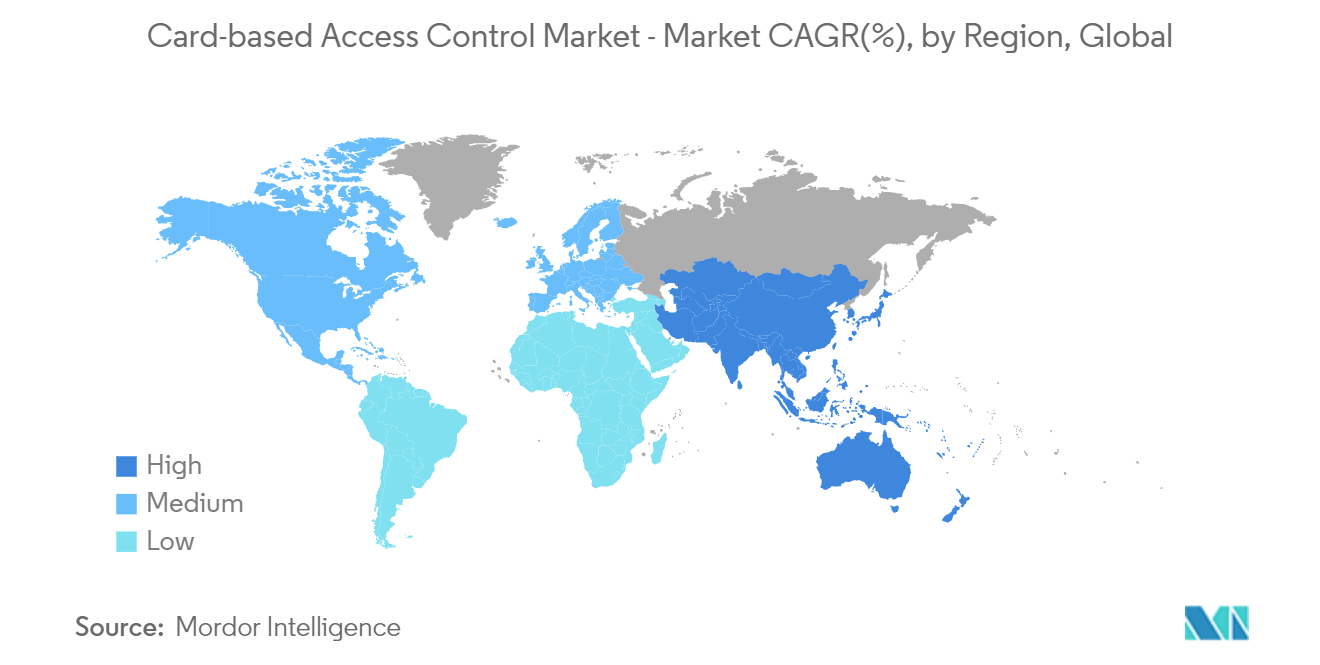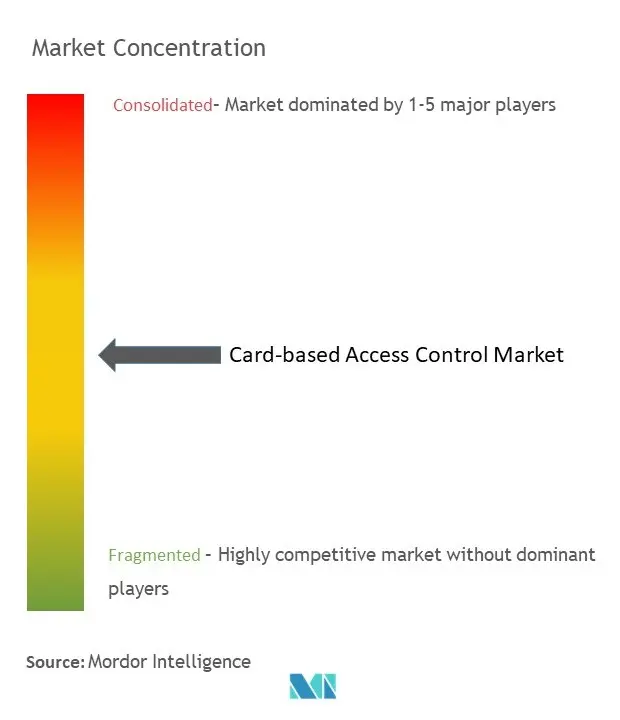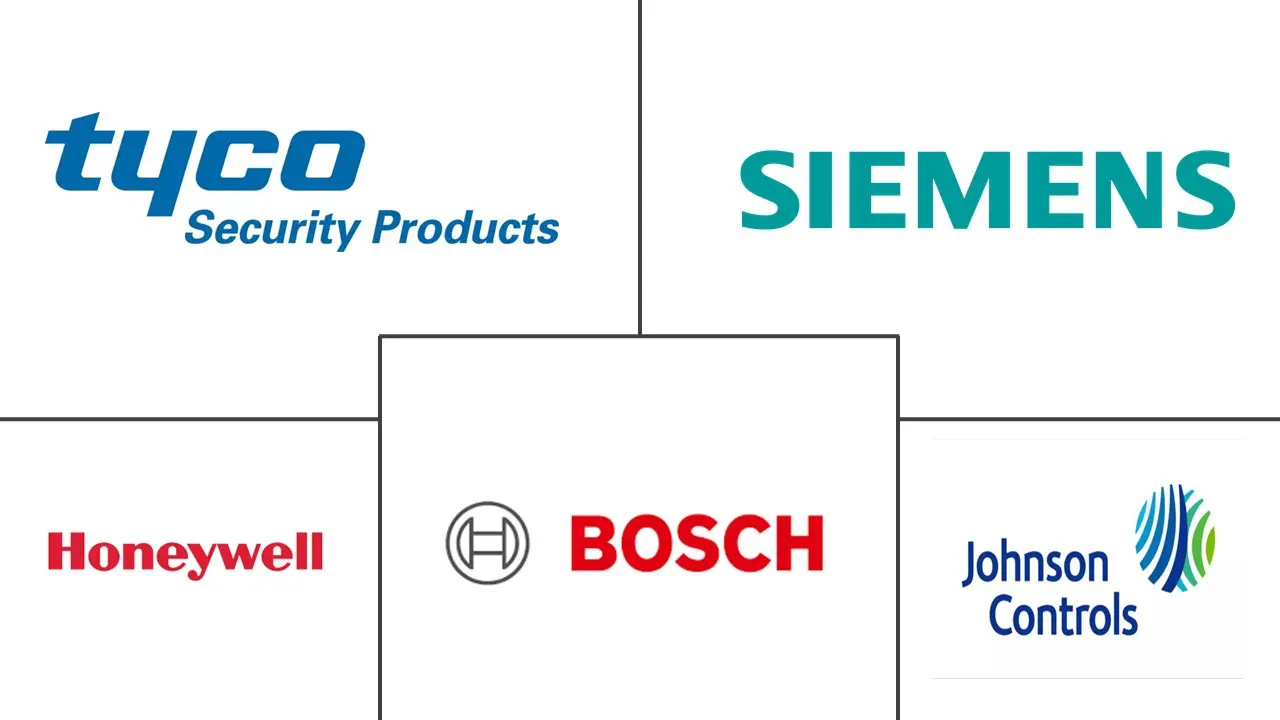Card-based Access Control Market Size and Share

Card-based Access Control Market Analysis by Mordor Intelligence
The Card-based Access Control Market size is estimated at USD 5.75 billion in 2025, and is expected to reach USD 7.84 billion by 2030, at a CAGR of 6.4% during the forecast period (2025-2030).
The rising global crime rates, coupled with the increasing urban population, underscore the imperative for robust data and asset security, propelling the global demand for Card-based Access Control systems.
- Card readers, a staple in access control systems, offer heightened security compared to PIN-based systems. Over time, these access control cards have advanced, adapting to the evolving security landscape. Notably, a rising trend is the integration of card-based electronic access control with electronic alarm systems for swift responses.
- Primarily used to bolster physical security at entry points, access control cards store user credentials, dictating access permissions. While primarily used for access management, these cards serve dual purposes, facilitating transactions with advanced technologies, including contactless smart cards. Moreover, the heightened emphasis on robust government security policies has further fueled the Card-based Access Control market.
- With the advent of the COVID-19 pandemic, the demand for contactless Card-based Access Control surged. The pandemic underscored the importance of social distancing and the need for surfaces to be bacteria-free. Governments globally recognized the pivotal role of security and access control during the crisis, elevating contactless solutions to the forefront.
- Yet, as businesses grappled with securing their assets remotely, challenges emerged. Cost, compatibility, and maintenance complexities added to the hurdles faced by companies utilizing Card-based Access Control.
- Despite the advantages, Card-based Access Control systems face challenges, including issues like unauthorized access due to misplaced credentials, integration gaps with other building systems, and reliance on outdated technology. Addressing these concerns is crucial to sustaining the market's growth trajectory.
- Looking ahead, heightened R&D investments by key market players, combined with benefits like streamlined access, enhanced crew protection, data breach prevention, and robust property security, are set to bolster the Card-based Access Control Market in the coming years.
Global Card-based Access Control Market Trends and Insights
Increasing Adoption of Smart Card Promotes Market Growth
- When selecting a card-based access control system, facility managers are faced with a range of options, including magnetic stripe cards, proprietary proximity cards, and smart cards. Many find that an integrated, intelligent card approach offers the most advantages.
- Smart cards featuring embedded computer chips or RFID tags come in memory or microprocessor variants. They store and transmit information, value, or a mix of both and are read by specialized readers. Smart card systems boast superior security, interoperability, durability, and functionality compared to traditional methods like magnetic stripes or barcodes.
- Yet, challenges like compatibility, costs, and maintenance accompany these innovative systems. Looking ahead, trends point to multi-application, dynamic, intelligent cards capable of executing numerous functions simultaneously.
- Cloud-based and mobile smart cards empower users to access their credentials from any device or location. Biometric and cryptographic smart cards, on the other hand, enhance security and privacy through integrated sensors and algorithms. Personalization features allow users to tailor profiles and preferences.
- Access control systems, utilizing various card types, are pivotal for organizations, ensuring data, networks, and workstations are accessible only to authorized personnel. Both commercial and government entities are increasingly turning to these systems for resource management and security.
- Organizations, regardless of size, seek reliable and innovative access control solutions to safeguard their premises. For example, HID Global Corporation, under ASSA ABLOY, has facilitated swift access to hospitals, offices, and classrooms for millions. Such initiatives from market players are set to bolster the global Card-based Access Control Market in the coming years.
- Furthermore, with a surge in infrastructure spending and a rising global adoption of smart Card-based Access Control, the market is poised for significant growth.

Asia-Pacific Is Expected To Grow At A Faster Pace
- With rising security concerns and escalating crime rates in the Asia-Pacific region, access control solutions are now prevalent in various settings, from data centers and offices to hotels, retail stores, and government institutions.
- The market growth in the region is primarily fueled by the increased adoption of access control systems in both commercial and defense sectors. Notably, private and government entities are ramping up investments in these systems to bolster data security and ensure a safer environment for their personnel.
- In a notable move, in February 2023, the Bureau of Indian Standards (BIS) greenlit the Alcatraz AI access control Rock system, emphasizing biometric access for buildings. Leveraging facial authentication, this approval underscores a broader trend where regional authorities' initiatives, like this one, are set to drive the demand for Card-based Access Control solutions in the coming years.
- Countries like India, China, and Japan, witnessing rapid urbanization and globalization, are at the forefront of bolstering security measures in government buildings, IT hubs, and commercial spaces. The introduction of advanced, contactless smart card systems further fuels the demand, given their seamless user experience.
- As the smart home trend gains momentum, security emerges as a paramount concern for consumers. From video door monitoring to motion-sensing cameras with night vision, the market is witnessing a surge in demand for security-enhancing gadgets, often integrated with Card-based Access Control systems.
- Additionally, the industrial sector in the region is increasingly embracing technology, setting the stage for heightened demand in the coming years. Access control solutions are finding applications not just in industrial settings but also in the burgeoning residential and commercial developments. For instance, the Indian government's ambitious projects, like the 100 Smart Cities Mission and Make in India, underscore a broader push towards infrastructure development.

Competitive Landscape
The Card-based Access Control Market has various major players that have been using various strategies, such as new product launches, joint ventures, expansions, partnerships, acquisitions, and others, to increase their footprints in this market, which is giving a high rivalry to the local players. The Card-based Access Control Market is moderately competitive. Some of the key players include Honeywell International Inc., Robert Bosch GmbH, Johnson Controls, Siemens, and Tyco Security Products, among others. Some of the recent developments in the market include:
- April 2024: Vitaprotech Group which acquired Tdsi, an integrated security manufacturer gave recently inked a deal with Identiv, a US-based company, to purchase its security business for a substantial USD 145 million. This move solidifies their position as a dominant force in cyber-secure physical security solutions, catering to a diverse clientele including enterprises, hospitals, OSE, and government entities.
- April 2024: Assa Abloy, a leading player in the access control market, completed the acquisition of Messerschmitt Systems, a prominent German manufacturer specializing in access control hardware and software tailored for the hospitality sector. In 2023, Messerschmitt Systems reported sales of approximately USD 11.8 million. While the acquisition is expected to have a minor dilutive impact on Assa Abloy's earnings per share initially, it strategically bolsters the company's portfolio. Messerschmitt Systems' offerings encompass a range of innovative products, from key card-activated door locks to in-room controls for lighting, curtains, and air conditioning, catering specifically to the needs of the hospitality industry.
Card-based Access Control Industry Leaders
-
Honeywell International Inc.
-
Robert Bosch GmbH
-
Johnson Controls
-
Siemens
-
Tyco Security Products
- *Disclaimer: Major Players sorted in no particular order

Recent Industry Developments
- May 2024: Akuvox has unveiled its latest smart access control lineup, featuring the A01, A02, A03, and A05 access control terminals, alongside the A092 door controller. These offerings cater to both residential and commercial segments. The A01, A02, and A03 terminals from Akuvox offer traditional PIN code (A02 exclusively), RFID card authentication, and mobile access. On the other hand, the A05, equipped with a 5-inch touchscreen and dual cameras, provides a more advanced feature set, supporting face recognition, NFC, QR code, RFID cards, and mobile app authentication.
- February 2024: Hikvision recently introduced its latest line of professional access control products, marking a notable advancement in access management. These new offerings boast enhanced features, such as web-based management, versatile authentication methods, specialized access applications, and integrated security solutions. The unveiling took place at a worldwide online event, where Hikvision's access control experts not only highlighted current industry trends but also showcased the brand's cutting-edge innovations.
Global Card-based Access Control Market Report Scope
Access control products allow the end-users to authenticate the personnel accessing an organization's physical infrastructure. With access control with a card reader, an employee, visitor, or guest uses a digital access card as a key. The card works with a special card reader to read the data linked to the card and its user. The market is defined by the revenue accrued from the sales of different card types that come with different components over various end users across the Americas, Asia-Pacific, Europe, Middle East, and Africa.
The card-based access control market is segmented by card type (swipe cards, RFID proximity cards, and smart cards [contact and contactless]), by end-user vertical (retail, BFSI, government, and commercial offices, military and defense, entertainment and media, and healthcare), and geography (Americas, Asia Pacific, Europe, Middle East, and Africa). The market sizes and forecasts are provided in terms of value in USD for all the above segments.
| Swipe Crads |
| RFID Proximity Crads |
| Smart card (contact and contactless) |
| Retail |
| BFSI |
| Government and Commercial Offices |
| Military and Defense |
| Entertainment and Media |
| Healthcare |
| Others |
| Americas |
| Asia |
| Australia |
| New Zealand |
| Europe |
| Middle East and Africa |
| By Card Type | Swipe Crads |
| RFID Proximity Crads | |
| Smart card (contact and contactless) | |
| By End-user Vertical | Retail |
| BFSI | |
| Government and Commercial Offices | |
| Military and Defense | |
| Entertainment and Media | |
| Healthcare | |
| Others | |
| By Geography | Americas |
| Asia | |
| Australia | |
| New Zealand | |
| Europe | |
| Middle East and Africa |
Key Questions Answered in the Report
How big is the Card-based Access Control Market?
The Card-based Access Control Market size is expected to reach USD 5.75 billion in 2025 and grow at a CAGR of 6.40% to reach USD 7.84 billion by 2030.
What is the current Card-based Access Control Market size?
In 2025, the Card-based Access Control Market size is expected to reach USD 5.75 billion.
Who are the key players in Card-based Access Control Market?
Honeywell International Inc., Robert Bosch GmbH, Johnson Controls, Siemens and Tyco Security Products are the major companies operating in the Card-based Access Control Market.
Which is the fastest growing region in Card-based Access Control Market?
Asia Pacific is estimated to grow at the highest CAGR over the forecast period (2025-2030).
Which region has the biggest share in Card-based Access Control Market?
In 2025, the Americas accounts for the largest market share in Card-based Access Control Market.
What years does this Card-based Access Control Market cover, and what was the market size in 2024?
In 2024, the Card-based Access Control Market size was estimated at USD 5.38 billion. The report covers the Card-based Access Control Market historical market size for years: 2019, 2020, 2021, 2022, 2023 and 2024. The report also forecasts the Card-based Access Control Market size for years: 2025, 2026, 2027, 2028, 2029 and 2030.
Page last updated on:
Card-based Access Control Market Report
Statistics for the 2025 Card-based Access Control market share, size and revenue growth rate, created by Mordor Intelligence™ Industry Reports. Card-based Access Control analysis includes a market forecast outlook for 2025 to 2030 and historical overview. Get a sample of this industry analysis as a free report PDF download.



